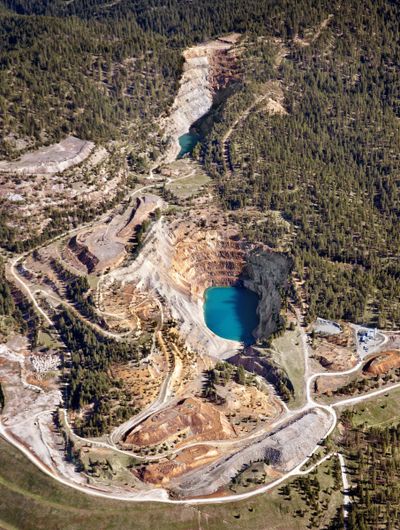Newmont Mining asks to relax radiation cleanup standards at Midnite Mine on Spokane Indian Reservation

The company responsible for cleaning up the Midnite Mine on the Spokane Indian Reservation has asked the federal government to relax cleanup standards for radiation at the defunct uranium mine.
Newmont Mining Corp. sent a memo to the U.S. Environmental Protection Agency last year, saying the mine site has high, naturally occurring levels of radium-226 and lead-210.
After Newmont began remediation work at the Midnite Mine in 2016, company officials said they encountered background levels of the two radioactive isotopes that exceeded the cleanup standards established in the 2006 federal record of decision.
“The company is committed to the cleanup. We want to do it right, but also productively and cost-effectively,” said Bill Lyle, Newmont’s alternate Midnite Mine project coordinator.
To do that, Newmont needs “achievable” radiation levels for the 350-acre mine site above the Spokane River, Lyle said. In some spots, the native bedrock has higher readings than the cleanup threshold, he said.
Located about 45 miles northwest of Spokane, the Midnite Mine opened in the 1950s to produce uranium during the U.S.-Soviet nuclear arms race. It closed in 1981 after a drop in uranium prices.
The mine and its mill in Ford, Washington, brought hundreds of good-paying jobs to the reservation. But many tribal members believe uranium mining and processing of the ore is responsible for elevated cancer rates on the reservation.
Exposure to radium over long periods is associated with a higher cancer risk, particularly for bone cancer, and lead-210 exposure is associated with increased risk for lung cancer, according to the Agency for Toxic Substances and Disease Registry.
The SHAWL Society, an environmental activist group formed by tribal members, held a community meeting about Newmont’s proposal in Spokane last month. Relaxing the cleanup standards raises health and safety concerns, said Twa-le Abrahamson-Swan.
Abrahamson-Swan is the daughter of SHAWL Society founder Deb Abrahamson, who is battling cancer. Tribal members have waited decades for the cleanup of the open-pit uranium mine and they want to ensure it’s done correctly, Abrahamson-Swan said.
“My mom has been doing this since I was in high school,” she said of the activist work. “We’re working with one of the largest mining companies in the world. We have to stand our ground.”
The Midnite Mine lies in the watershed of Blue Creek, a tributary of the Spokane River where tribal members had sweat lodges and gathered native plants. Signs in the Blue Creek drainage warn people not to drink from the streams or eat fish, plants or animals taken from the area.
“We are a traditional people” who gather roots and berries, fish and hunt, said Margo Hill, a member of the Spokane Tribe. “It’s a high cost when the contamination doesn’t get cleaned up. … Every year that passes is a critical loss for us.”
Lyle, Newmont’s project coordinator, said the federal record of decision for the Midnite Mine’s cleanup allows for standards to be modified based on lessons learned during the remediation work.
Newmont cited a December 2017 memo from a former EPA manager in its request to the agency. The memo said the agency typically doesn’t call for cleanup standards that are higher than natural background levels.
The footprint for the Midnite Mine’s cleanup could expand significantly if EPA requires removal of radioactive material from undisturbed ground, Lyle said.
“The last thing we want to do is to go out and tear everything up trying to find something we can’t achieve,” he said.
Linda Meyer, who recently took over as the EPA’s project manager for the Midnite Mine cleanup, said the agency has not made a decision on Newmont’s request.
“It will be based on a technical assessment. It is not a given,” she said.
If agency officials recommend changing cleanup levels, the decision-making would go through a formal process with opportunities for public input, Meyer said.
About 33 million tons of radioactive waste rock and ore remain at the Midnite Mine site.
The remediation plan calls for filling the open pits left from the mine with the waste rock and ore. The pits would be capped to keep radon gas from escaping. Groundwater in the pits will be collected and treated and then piped 7 miles to the Spokane River.
Newmont already collects and treats water at the old mine site, but that water is currently discharged into Blue Creek. Discharging the treated wastewater directly into the Spokane River will reduce the impact to the creek, where the tribe is working to re-establish a native redband trout run.
Newmont has a 2025 deadline for completing the cleanup.
Under a consent decree signed with the federal government, Newmont and its subsidiary, Dawn Mining, will pay for most of the work. The U.S. Department of the Interior contributed $42 million for cleanup activities for failing to fulfill federal trust responsibilities to the Spokane Tribe through proper oversight of the mine during its operation.